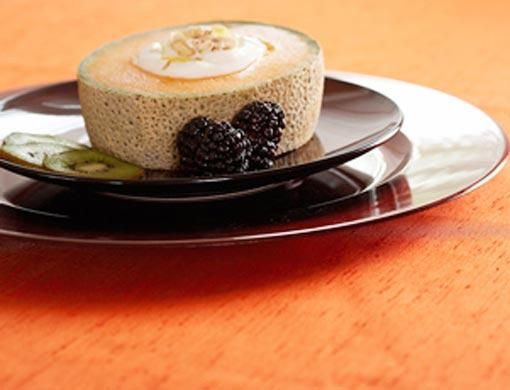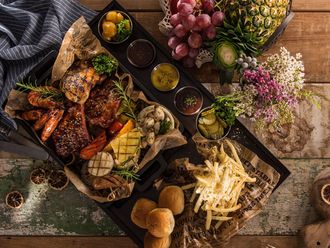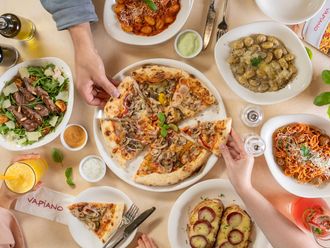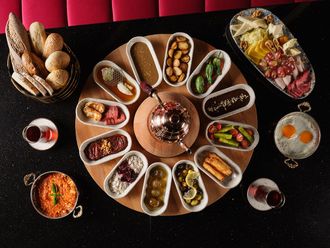The 13th Gulfood Exhibition, organised by the Dubai World Trade Centre at the Dubai International Convention and Exhibition Centre, runs from February 24 to 27.
Home to more than 200 nationalities, the UAE serves cuisine and food products from every part of the world.
When we talk of food capitals, Paris, Tokyo, London and New York spring to mind. Dubai, though, is catching up fast with these cities as one of the leading destinations to enjoy quality food and hospitality services. Gourmet food stores, organic supermarkets, spice souqs, speciality food stores, fish markets, international hypermarket chains and little neighbourhood grocery stores stock everything from quail eggs, amaranth spelt bread, white truffle oil, Wagyu beef, Norwegian salmon, Pakistani mutton and rambutan to Belgian chocolate and vanilla flavoured sugar. Exclusive restaurants such as Verre, Vu's, Okku, Magnolia, Tang, Spectrum on One, Zheng He's, Yalumba, Asha's, Al Mahara, Sukhothai, Latino House, Medzo and Marrakesh also offer gourmands a platter of delectable delicacies with a multicultural flavour. Even celebrity chefs such as Gordon Ramsay, Antony Worall Thompson and Gary Rhodes can't get enough of the emirate's zest for great food.
The emirate's growing population, thriving economy, and profile as one of the region's 'hottest' tourist destinations has only whet Dubai's appetite for quality food products and hospitality services. It has also worked in making Gulfood, the region's most anticipated food, drink, foodservice and hospitality equipment exhibition, into an event of international significance. Organised by the Dubai World Trade Centre since 1987, the event has emerged as a strategic platform for manufacturers, distributors and suppliers from around the world, representing all of the key sectors within the food and hospitality trade.
Ideal venue
Several reasons qualify Dubai as the ideal venue for the trade show, which runs from February 24 to 27 at the Dubai International Convention and Exhibition Centre this year. Elly Habt, Project Manager Gulfood, Dubai World Trade Centre LLC, lists a few: "Re-export plays a major role, since Dubai is a natural hub for exports to a market that includes the Arab world and extends to Africa, Eastern and Central Europe and Asia.
The UAE is home to one of the world's fastest-growing hotel and hospitality sectors with an additional 86,000 hotel rooms expected to hit the market by 2012 (according to the UAE Ministry of Finance and Industry). This creates a major market for hotel suppliers. Additionally, there is also major growth expected in the surrounding areas."
Habt also cites a report by TRI Hospitality Consulting stating that 128 new hotels will come into operation in the GCC in the period through 2009, delivering nearly 42,000 new rooms to the market.
Limited food resources in the UAE, though, have contributed significantly to the region's potential as a viable market for food and beverage companies from all over the world, especially with the population growing steadily. A Gulf News report (January 17) stated that annual food imports into the UAE had touched $4 billion and that the figure was forecast to increase in the coming years.
Demand for food products such as seafood and poultry, in particular, have been increasing in the UAE. The popularity of halal products is also growing steadily. Saleh Abdullah Lootah, Chief Executive Officer, Al Islami Foods, says that his company saw an increase in sales in 2007 due to imports of chicken from Brazil that were healthier and completely safe from the bird flu epidemic. Stringent quality control in food processing, says Lootah, also helped the company provide its consumers with quality products that are bonafide halal.
Confectionery is another area that is faring well in the UAE. Sachin Goel, Business Executive Manager, Confectionery Unit, Nestle Middle East, says that the growth rate experienced by the confectionery industry in the UAE was very impressive at 18 per cent year-on-year for the past three years.
"In 2007, the local UAE market was estimated to be worth $85 million, excluding sugar confectionery. The total Middle East market has grown by 15 per cent over the last three years but in particular Saudi Arabia and Qatar experienced the largest growth of 24 per cent and 23 per cent respectively. Overall all countries in the region are booming when it comes to this consumer category," he says.
Chocolate consumption is also growing across all major sub-categories in the UAE. Goel says that there is a significant increase in the 'premium chocolate' market here and that the consumer is spoiled for choice. "We see a fast growing 'chocolate assortments' sub-category with a diversified consumers profile purchasing these products throughout the year to celebrate important seasons from Ramadan to Christmas, Easter and Diwali.
Apart from specific ranges made available specifically for the region over these celebratory periods, there are also direct imports by some of the larger retailers. Other sub-categories, such as bars, are also rapidly growing in UAE. Kit Kat is by far the largest selling 'chocolate countline' bar in UAE as it is found in several countries throughout the Middle East and is very popular with both the local Arab consumer as well as the expatriate community," he says.
Gulfood's organisers say that with the highest per capita liquid consumption in the world, the Middle East market and wider region also holds great potential for companies in the drinks sector. The UAE, in fact, has reached the highest levels of consumption of 635 litres per capita a year compared to the global average of 197 litres in 2006. According to research by Zenith International, a consultancy that specialises in research for the international food and beverage sector, bottled water sales in the Middle East have more than doubled in the past five years.
Vijay Narain, Head - International Sales, International Beverage and Filling Industries, says that the UAE has witnessed a strong growth rate in soft beverage consumption during the period 2002-2006, which was almost 50 per cent higher than the GCC average for the same period.
"In the JNSD (juices, nectars and still drinks) category, the UAE's growth has been almost double the GCC average and was the highest among the GCC countries. Other categories that account for a smaller share of the beverage market but have shown high growth rates during this period are energy drinks and sports/health drinks, indicating a growing awareness among consumers towards health and well-being products," he says. In addition to being a viable market itself, the region also provides a point of entry to emerging markets with huge possibilities for growth such as Pakistan and India, which have dense populations but low bottled water penetration.
Such opportunities have worked strongly in attracting exhibitors to Gulfood in the past years. In 2007, the exhibition brought together more than 2,000 companies from 75 countries and featured 56 national pavilions. The exhibition attracted more than 35,000 visitors from 140 countries including buying delegations not only from the Middle East but also from Armenia, Canada, Egypt, India, Jordan, Kenya, Latvia, Malaysia, Morocco, Philippines, Russia, Sudan, Thailand, Tunisia, UK and the US.
Habt says that a number of new country pavilions, including Ecuador, Hungary, Lithuania, Malawi, Northern Ireland, Poland, Switzerland and Uruguay, are making their debut at Gulfood 2008. "The event is set to welcome more than 2,500 companies that specialise in the food and hospitality sector. Building on the large international presence at this year's show, over 86 per cent of these leading suppliers are from outside the UAE," says Habt.
International support
This year is also seeing an increase in representation from Europe, Asia and the Americas. "There will be a major delegation from the US, including the American Trading International Inc, which profiles the latest trends in US foods and beverages for export customers. We are also hosting a major delegation of over 35 Brazilian companies," says Habt.
Brazil's agri-business exports to the Arab world generated $4.6 billion (approximately Dh16.8 billion) last year, which comprised 66 per cent of Brazil's total exports to the region, with strong sales for beef, chicken and sugar.
Strong bilateral trade has also motivated Italy's presence at the show. Dr Ferdinando Fiore, the Italian Trade Commissioner, says that the UAE has been the main destination for Italian exports in the Middle East since 1999, overtaking Saudi Arabia, traditionally the main buyer of Italian products in the area.
Fiore says that more than 50 Italian companies are participating in Gulfood this year. The Italian Trade Commission has organised the participation of 20 companies from the two regions of Liguria and Puglia. The participants include the chamber of commerce of the province of Cremona in Lombardy that represents 11 companies that deal in a wide range of products that vary from foodstuff to hotel and restaurant equipment.
India and Malaysia
Malaysia has 45 companies exhibiting at Gulfood under the umbrella of Matrade (Malaysia External Trade Development Corporation).
Noraslan Hadi, Trade Commissioner of Malaysia, says that Malaysian food products are widely accepted in this part of the world because of its stringent standards and high quality. In addition, Malaysia's halal certification gives its food products an added advantage here.
"Malaysian exports of processed foodstuff to the UAE was recorded at Dh198 million between January and November 2007, up from Dh185 million during the corresponding period in 2006, mainly consisting of processed meat products, snack food and confectionery," says Hadi.
Indian participation at Gulfood 2008 has grown by 50 per cent making it the most significant ever according to organiser Dubai World Trade Centre (DWTC). The exhibitors include the Tea Board of India, Spices Board of India, Coffee Board of India and India's Agricultural and Processed Food Products Export Development Authority (APEDA).
In addition to increasing exhibition space by 20 per cent to accommodate the growing number of international participants, the organisers have a new dedicated focus on food packaging, labelling and processing equipment at the show.
"The process of 'sectorisation' has continued in 2008, with the introduction of Restaurant and Café Middle East 2008, a premier exhibition showcasing the latest innovations in interiors, equipment, supplies and services. We have also launched a specialist area for Beverage and Beverage Equipment which is accompanied by a series of Beverage Opportunity Workshops, organised by Zenith International," says Habt.
Many of the popular features from the earlier shows are also back for 2008. One of them, the Salon Culinaire, promises to cook up a storm.
This year the show has a panel of 25 international judges — each mandated by the World Association of Chefs Societies (WACS) — and 1,000 chefs competing for gold, silver and bronze. Another event that visitors can look forward to is the third Dubai International Food Safety Conference, organised by Dubai Municipality. The conference will have experts addressing the challenges and issues in the Middle East market.
This exciting line-up of events will definitely complement the main exhibition and ensure that visitors and exhibitors come back for more in 2009.
It was exactly what happened in 2007, causing exhibition space to sell out much in advance for the show this year.
Quick look: Event information
Gulfood is strictly a trade-only event and is restricted to business and trade visitors from within the industry, proof of which must be provided at registration. The general public and those under the age of 21 will not be allowed into the exhibition.
Interested trade visitors are advised to pre-register online at www.gulfood.com where they can qualify for free entry. Industry business professionals on the day of the show will be able to buy either a one-day pass for Dh40 ($11), or a four-day pass for Dh100 ($27).










